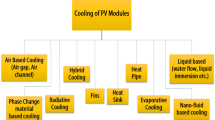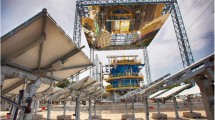Abstract
Thermo-electrochemical cells (or thermocells) convert thermal energy to electricity in continuous operation based on a balance of ion conduction and redox reactions at hot and cold electrodes. In this study, the fundamental governing equations for mass and heat transfer, fluid dynamics, and electrokinetics in thermocells are presented and solved numerically using COMSOL. A parametric study is performed to explore the limitations and optimal cell dimensions for maximum energy conversion efficiency in thermocells. Series-stacking designs are demonstrated to have the potential to increase conversion efficiency by 100 % compared to a single cell configuration. Natural convection is shown to significantly increase the conversion efficiency of thermocells with conventional aqueous electrolyte (0.4 M potassium ferri/ferrocyanide), by compressing the diffusive boundary layers. A flow cell thermocell design is also considered. Results reveal that the ohmic resistance of the electrolyte limits the energy conversion efficiency of this design.








Similar content being viewed by others
Abbreviations
- A :
-
Electrode surface area (m2)
- β T1 :
-
Temperature density change coefficient 1 (kg m−3)
- β T2 :
-
Temperature density change coefficient 2 (kg m−3 K−1)
- β T3 :
-
Temperature density change coefficient 3 (kg m−3 K−2)
- C p :
-
Electrolyte heat capacity (J kg−1 K−1)
- C i :
-
Ion concentration (mol m−3)
- \(C_{\text{i}}^{ *}\) :
-
Initial ion concentration (mol m−3)
- C O :
-
Oxidized concentration (mol m−3)
- C R :
-
Reduced concentration (mol m−3)
- C CI :
-
Counter-ion concentration (mol m−3)
- D i :
-
Ion diffusion coefficient (m2 s−1)
- D O :
-
Oxidized diffusion coefficient (m2 s−1)
- D R :
-
Reduced diffusion coefficient (m2 s−1)
- D CI :
-
Counter-ion diffusion coefficient (m2 s−1)
- ρ :
-
Electrolyte density (kg m−3)
- ρ o :
-
Electrolyte density reference at 300 K (kg m−3)
- ε :
-
Dielectric constant (A2 s4 kg−1 m−3)
- E :
-
Electrode potential (V)
- E°:
-
Standard electrode potential (V)
- E a :
-
Anode potential (V)
- \(E_{\text{a}}^{\text{eq}}\) :
-
Anode equilibrium potential (V)
- E c :
-
Cathode potential (V)
- \(E_{\text{c}}^{\text{eq}}\) :
-
Cathode equilibrium potential (V)
- \(E{x}_{\text{a}}\) :
-
Rate constant activation energy (J mol−1K−1)
- F:
-
Faraday constant (C mol−1)
- h e :
-
Effective heat transfer coefficient (W m−2 K−1)
- I o :
-
Optimum cell current (A)
- j :
-
Electronic current density (A m−2)
- j a :
-
Electronic current density at the anode (A m−2)
- j c :
-
Electronic current density at the cathode (A m−2)
- J sc :
-
Short-circuit current density (A m−2)
- j wc :
-
Electronic current density without convection (W m−2)
- k :
-
Electrochemical rate constant (m s−1)
- k 0 :
-
Standard rate constant (m s−1)
- κ s :
-
Electrolyte thermal conductivity (W m−1 K−1)
- κ e :
-
Electrode thermal conductivity (W m−1 K−1)
- \(\vec{N}_{\text{i}}\) :
-
Ion flux density (mol m−2 s−1)
- \(\vec{N}_{\text{O}}\) :
-
Oxidized flux density (mol m−2 s−1)
- \(\vec{N}_{\text{R}}\) :
-
Reduced flux density (mol m−2 s−1)
- \(\vec{N}_{\text{CI}}\) :
-
Counter-ion flux density (mol m−2 s−1)
- n :
-
Number of electrons transferred (−)
- η :
-
Conversion efficiency (%)
- η i :
-
Conversion efficiency of intermediate cell (%)
- η r :
-
Relative efficiency (%)
- ξ a :
-
Anode overpotential (V)
- ξ c :
-
Cathode overpotential (V)
- P e :
-
Electric power density (W m−2)
- P i :
-
Electric power of intermediate cell (W)
- P m :
-
Maximum electric power density (W m−2)
- q :
-
Heat flux density (W m−2)
- q wc :
-
Heat flux density without convection (W m−2)
- Q CI :
-
Counter-ion heat of transport (J mol−1)
- Q i :
-
Ion heat of transport (J mol−1)
- Q O :
-
Oxidized heat of transport (J mol−1)
- Q R :
-
Reduced heat of transport (J mol−1)
- R :
-
Gas constant (J mol−1K−1)
- \(\mathcal{R}_{T}\) :
-
Thermocell volume (m3)
- S :
-
Heat generation sources (W m−3)
- T :
-
Temperature (K)
- T a :
-
Anode temperature (K)
- T c :
-
Cathode temperature (K)
- T H :
-
Temperature at the hot electrode (K)
- T o :
-
Standard temperature (K)
- U C :
-
Cold flow temperature (K)
- U H :
-
Hot flow temperature (K)
- u i :
-
Ion mobility (m2 s−1 V−1)
- \(\vec{u}\) :
-
Bulk vector velocity (m s−1)
- \({{\upupsilon}}\) :
-
Kinematic viscosity (m2 s−1)
- V o :
-
Optimum cell voltage (V)
- V oc :
-
Open-circuit cell voltage (V)
- V T :
-
Cell voltage (V)
- Z CI :
-
Counter-ion charge number (−)
- Z i :
-
Ion charge number (−)
- Z O :
-
Oxidized charge number (−)
- Z R :
-
Reduced charge number (−)
- ϕ :
-
Electrostatic potential (V)
- θ :
-
Charge transfer coefficient (−)
- ∆ϕ s :
-
Solution ohmic drop (V)
- \(\Updelta S_{{\text{rx}}}^{\circ}\) :
-
Standard electrochemical redox reaction entropy (J mol−1 K−1)
- \(\Updelta H_{{\text{rx}}}^{\circ}\) :
-
Standard electrochemical redox reaction enthalpy (J mol−1)
- \(\Updelta G_{{\text{rx}}}^{\circ}\) :
-
Standard electrochemical redox reaction free energy (J mol−1)
- ∫ a :
-
Integral at the anode surface
- ∫ c :
-
Integral at the cathode surface
- ∫ T :
-
Integral in the thermocell
References
Hendricks T, Choate WT (2006) Engineering scoping study of thermoelectric generator systems for industrial waste heat recovery. U.S. Department of Energy, Washington, DC
Yang J, Caillat T (2006) Thermoelectric materials for space and automotive power generation. MRS Bull 31(03):224–229. doi:10.1557/mrs2006.49
Hu R, Cola BA, Haram N, Barisci JN, Lee S, Stoughton S, Wallace G, Too C, Thomas M, Gestos A, Cruz MEd, Ferraris JP, Zakhidov AA, Baughman RH (2010) Harvesting waste thermal energy using a carbon-nanotube-based thermo-electrochemical cell. Nano Lett 10(3):838–846. doi:10.1021/nl903267n
Agar JN (1963) Thermogalvanic cells. In: Delay P, Tobias CW (eds) Advances in electrochemistry and electrochemical engineering, vol 3. Interscience, New York, pp 31–121
deBethune AJ (1960) Irreversible thermodynamics in electrochemistry. J Electrochem Soc 107(10):829–842
Tyrrell HJ (1961) Diffusion and heat flow in liquids. Butterworths, London
Agar JN (1960) The rate of attainment of Soret equilibrium. Trans Faraday Soc 56:776–787
Hupp JT, Weaver MJ (1984) Solvent, ligand, and ionic charge effects on reaction entropies for simple transition-metal redox couples. Inorg Chem 23(22):3639–3644. doi:10.1021/ic00190a042
Chum HL, Osteryoung RA (1981) Review of thermally regenerative electrochemcial systems, vol 1–2. U.S. Department of Energy, Washington, DC
Ikeshoji T (1987) Thermoelectric conversion by thin-layer thermogalvanic cells with soluble redox couples. Bull Chem Soc Jpn 60(4):1505–1514. doi:10.1246/bcsj.60.1505
Mua Y, Quickenden TI (1996) Power conversion efficiency, electrode separation, and overpotential in the ferricyanide/ferrocyanide thermogalvanic cell. J Electrochem Soc 143(8):2558–2564. doi:10.1149/1.1837047
Quickenden TI, Mua Y (1995) A review of power generation in aqueous thermogalvanic cells. J Electrochem Soc 142(11):3985–3994
Quickenden TI, Vernon CF (1986) Thermogalvanic conversion of heat to electricity. Sol Energy 36(1):63–72. doi:10.1016/0038-092x(86)90061-7
Nugent JM, Santhanam KSV, Rubio A, Ajayan PM (2001) Fast electron transfer kinetics on multiwalled carbon nanotube microbundle electrodes. Nano Lett 1(2):87–91. doi:10.1021/nl005521z
Abraham TJ, MacFarlane DR, Pringle JM (2011) Seebeck coefficients in ionic liquids—prospects for thermo-electrochemical cells. Chem Commun 47(22):6260–6262
Hudak NS, Amatucci GG (2011) Energy harvesting and storage with lithium-ion thermogalvanic Cells. J Electrochem Soc 158(5):A572–A579. doi:10.1149/1.3568820
Migita T, Tachikawa N, Katayama Y, Miura T (2009) Thermoelectromotive force of some redox couples in an amide-type room-temperature ionic liquid. Electrochemistry 77(8):639–641
Sokirko AV (1994) Theoretical study of thermogalvanic cells in steady state. Electrochim Acta 39(4):597–609. doi:10.1016/0013-4686(94)80106-1
Ikeshoji T, de Nahui FNB, Kimura S, Yoneya M (1991) Computer analysis on natural convection in thin-layer thermocells with a soluble redox couple: Part 2. E-I relation, electric power, heat flux and electrochemical heat pump. J Electroanal Chem 312(1–2):43–56. doi:10.1016/0022-0728(91)85143-d
Ikeshoji T, Kimura S, de Nahui FNB, Yoneya M (1991) Computer analysis of natural convection in thin-layer thermocells with a soluble redox couple: Part 1. Method and the unsteady problem. J Electroanal Chem 307(1–2):29–45. doi:10.1016/0022-0728(91)85537-y
Newman J (1995) Thermoelectric effects in electrochemical systems. Ind Eng Chem Res 34(10):3208–3216. doi:10.1021/ie00037a005
Bard AJ (2001) Electrochemical methods: fundamentals and applications, 2nd edn. Wiley, Hoboken
Bockris JOM (1973) Modern electrochemistry: an introduction to an interdisciplinary area vol 2. Plenum Press, New York
Newman JS (1991) Electrochemical systems, 2nd edn. Prentice-Hall, Englewood Cliffs
Saraç H, Patrick MA, Wragg AA (1993) Physical properties of the ternary electrolyte potassium ferri-ferrocyanide in aqueous sodium hydroxide solution in the range 10–90 °C. J Appl Electrochem 23(1):51–55. doi:10.1007/bf00241575
Salazar PF, Kumar S, Cola BA (2012) Nitrogen- and boron-doped carbon nanotube electrodes in a thermo-electrochemical cell. J Electrochem Soc 159(5):B483–B488. doi:10.1149/2.043205jes
Pentrice GA (1991) Electrochemical engineering principles. Prentice Hall, Englewood Cliffs
Breck WG, Lin J (1965) Thermal diffusion studies with redox electrodes. Part 2. Ferro-ferricyanide couple. Trans Faraday Soc 61:1511–1515
Daum PH, Enke CG (1969) Electrochemical kinetics of the ferri-ferrocyanide couple on platinum. Anal Chem 41(4):653–656. doi:10.1021/ac60273a007
Spiro M (1964) Standard exchange current densities of redox systems at platinum electrodes. Electrochimica Acta 9(11):1531–1537
Acknowledgments
We are grateful for the financial support of National Science Foundation Award No. CBET 1055479.
Author information
Authors and Affiliations
Corresponding author
Rights and permissions
About this article
Cite this article
Salazar, P.F., Kumar, S. & Cola, B.A. Design and optimization of thermo-electrochemical cells. J Appl Electrochem 44, 325–336 (2014). https://doi.org/10.1007/s10800-013-0638-y
Received:
Accepted:
Published:
Issue Date:
DOI: https://doi.org/10.1007/s10800-013-0638-y




